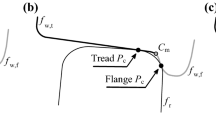Abstract
The simulation of the braking maneuver of a railway vehicle under degraded adhesion conditions is very important concerning the safety of railway operation. However, the implementation of a realistic friction law is comparatively difficult because of the complex and nonlinear behavior of the wheel-rail contact. Particularly under degraded adhesion conditions, very high creepages occur, which cause sliding in the contact. This sliding produces a high dissipation of energy, which has a cleaning effect on the rolling surfaces, and thereby strengthens the influence of the adhesion. In this work, this energetic criterion has been studied. The authors suggest implementing an innovative friction law to the simulation of railway multibody models with 3D multi-point contact detection algorithms. As a benchmark case, the braking of a coach equipped with a Wheel Slide Protection (WSP) system is simulated. The results are compared with experimental data available from previous testing activities by Trenitalia. The new friction law provides to match the experimental reference results and to carry out simulated braking tests, including the working WSP system, which comply with the current regulations (Railway applications, braking, wheel slide protection, UNI EN 15595, 2009).

























Similar content being viewed by others
References
Pneumatic fluid power. Components using compressible fluids. Determination of flow-rate characteristics. UNI ISO 6358 (1992)
Brakes-air brakes for freight trains and passenger trains. UIC 540 (2006)
Braking questions “methodology for the safety margin etcs/ertms”—dt 414. UIC B126.15. C Group (2006)
Railway applications, braking, wheel slide protection. UNI EN 15595. Milano, Maggio (2009)
Brakes—specifications for the construction of various brake parts—wheel slide protection device (wsp). UIC 541-05 (2005)
Allotta, B., Pugi, L., Ridolfi, A., Malvezzi, M., Vettori, G., Rindi, A.: Evaluation of odometry algorithm performances using a railway vehicle dynamic model. Vehicle system dynamics. Int. J. Veh. Mech. Mobil. 50(5), 699–724 (2012)
Amyot, J., Dukkipati, R.: Computer-Aided Simulation in Railway Dynamics. Dekker, New York (1988)
Arias-Cuevas, O., Li, Z., Popovici, R., Schipper, D.: Simulation of curving behaviour under lubricated wheel-rail contact. In: Proceedings of IAVSD 2009, Stockholm (2009)
Belforte, G.: Manuale di pneumatica. Tecniche Nuove, Torino (1995)
Blau, P.: Embedding wear models into friction models. Tribol. Lett. 34, 75–79 (2009). doi:10.1007/s11249-008-9395-1
Boiteux, M.: Le probleme de l’adherence en freinage. In: Revue Generale des Chemins de Fer, pp. 59–72 (1986)
Esveld, C.: Modern railway track. Delft University of Technology, Delft, Netherlands (2001)
Grimm, R., Andersen, E.: Identification of rail-wheel adhesion. In: SPEEDAM 2000 Symposium on Power Electronics Electrical Drives Automation and Motion, Ischia, Italy (2000)
Iwnicki, S.: Handbook of Railway Vehicle Dynamics. Taylor and Francis, Boca Raton (2006)
Kalker, J.: Three-Dimensional Elastic Bodies in Rolling Contact. Kluwer Academic, Dordrecht (1990)
Magheri, S., Malvezzi, M., Meli, E., Rindi, A.: An innovative wheelrail contact model for multibody applications. Wear 271(1), 462–471 (2011)
Malvezzi, M., Allotta, B., Pugi, L.: Feasibility of degraded adhesion tests in a locomotive roller rig. Proc. ImechE, Part F. J. Rail Rapid Transit 222, 27–43 (2008)
Malvezzi, M., Meli, E., Falomi, S.: Multibody modeling of railway vehicles: innovative algorithms for the detection of wheelrail contact points. Wear 271(1), 453–461 (2011)
Meli, E., Falomi, S., Malvezzi, M., Rindi, A.: Determination of wheel–rail contact points with semianalytic methods. Multibody Syst. Dyn. 20(4), 327–358 (2008)
Polach, O.: Creep forces in simulations of traction vehicles running on adhesion limit. Wear 258, 992–1000 (2005)
Pugi, L., Malvezzi, M., Allotta, B., Banchi, L., Presciani, P.: A parametric library for the simulation of a union internationale des chemins de fer (uic) pneumatic braking system. Proc. Inst. Mech. Eng., F J. Rail Rapid Transit 218, 117–132 (2004)
Pugi, L., Malvezzi, M., Tarasconi, A., Palazzolo, A., Cocci, G., Violani, M.: Hil simulation of wsp systems on mi-6 test rig. Veh. Syst. Dyn. 44(suppl), 843–852 (2006)
Pugi, L., Ridolfi, A., Malvezzi, M., Cangioli, F., Rindi, A.: Three dimensional modelling of wheel-rail degraded adhesion conditions. In: Proceedings of IAVSD 2011, Manchester (2011)
Pugi, L., Rinchi, M., Malvezzi, M., Cocci, G.: A multipurpose platform for hil testing of safe relevant railway subsystem. In: AIM IEEE-ASME Advanced Intelligent Mechatronics, Monterey, USA (2005)
Toni, P., Malvezzi, M., Pugi, L., Rinchi, M., Presciani, P.: Sviluppo e validazione di algoritmi di odometria per sistemi di controllo e monitoraggio ferroviari. In: Ingegneria Ferroviaria, pp. 433–457 (2003)
Trenitalia, R.F.I.: Internal report of trenitalia spa and rete ferroviaria italiana, Roma (2005)
Vicuna, G.: Organizzazione e Tecnica Ferroviaria. Ed. CIFI, Roma (1986)
Acknowledgements
The authors would like to thank the Trenitalia archives for supplying experimental data relative to braking tests under degraded adhesion conditions.
Author information
Authors and Affiliations
Corresponding author
Rights and permissions
About this article
Cite this article
Meli, E., Pugi, L. & Ridolfi, A. An innovative degraded adhesion model for multibody applications in the railway field. Multibody Syst Dyn 32, 133–157 (2014). https://doi.org/10.1007/s11044-013-9400-9
Received:
Accepted:
Published:
Issue Date:
DOI: https://doi.org/10.1007/s11044-013-9400-9




